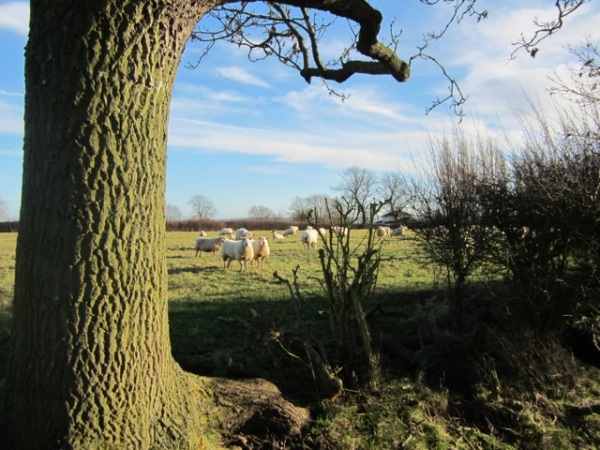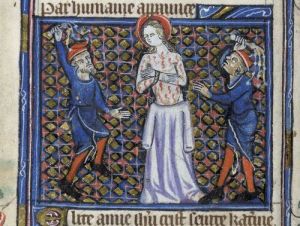
The picture above shows the abandoned graveyard of a church that was in use for at least 600 years. I wrote a little bit about this church a few weeks ago, when I was talking about the way in which people in certain areas of this country – perhaps in particular the East Midlands – become disconnected from their medieval heritage of culture and literature, and how we need to reclaim that heritage. As an academic, I feel incredibly lucky that I get to read manuscripts that are hundreds of years old, to see the notes quite ordinary people jotted in the margins of their books, at to feel a momentary connection with lives lived in an entirely different time. But, because I’m not an archaeologist, I don’t go to look at the places where people lived as often as I might. So when I went back to see if I could find this graveyard, I found it fascinating and humbling.
Kinoulton’s old church – dedicated to St Wilfrid and probably built in the twelfth century – is now nothing more than a series of mounds and stony hummocks on a hillside, whose shadows mark out the ghost of a building.
To get to Kinoulton, these days a little modern village, you turn off the A46, the old Roman Fosseway, between Leicester and Newark. You find yourself on a steep hill looking down into the Vale of Belvoir. But instead of continuing on down, you park at the top of the hill and you follow the bridleway through the gate.

There’s a field to the side, full of vaguely curious sheep and, when we went, bordered by a large ditch full of water. Up to this point, you’re definitely on the footpath, but I admit, I did climb the gate after this. If by some extremely long shot the owner of this land is reading: I hope this was ok, and I would love to know whether or not the graveyard is accessible, as I remember it being on the footpath when I was a child.

Jumping over the ditch and crossing the field, you come to a sloping field, with a view across into the Vale and a tangle of brambles, thorns and unmown grass interrupted by a few wildly slanting grave stones.

These stones mostly date from the eighteenth century, and feature the sorts of rhyming verses, couplets and quotations from the Bible that you’d expect:
“Time flies, Our Glory Fades, and Death at Hand”
reads the inscription on one tomb, flamboyantly decorated with an Angel of Death holding a scythe, bestriding a globe featuring lines of latitude and longitude and writhing, apocalyptic serpents. A dancing skeleton completes the image. There’s a wonderful picture of it on flickr – please look, if you click on it the detail is amazing. Another inscription berates ‘Pale Death’ that has killed ‘so good a wife, so kind a mother’. This form of reference reminded me of the epitaph on Mary Sidney, written in 1621:
“Underneath this sable hearse,
Lies the subject of all verse,
Sidney’s sister, Pembroke’s mother.
Death, ere thou hast slain another
Fair and learned and good as she,
Time shall throw a dart at thee.”
Strip away the better poetry of the latter and you have the same sentiment, defining a woman in terms of her relations to her male family, and the same slightly macabre reminder of the physical reality of a body lying just feet away under the tombstone. In Kinoulton graveyard, further gruesome images (which I couldn’t help finding quite appealing) come in the form of skulls with crossed bones, worried expressions on their faces:

A more elaborate memorial is shared by several of the graves: a carved angel, with an oddly impassive face and wings spread wide. These carvings are known as ‘Belvoir Angels’ and you find them throughout the area. Although Kinoulton is now one of the smaller villages in the vale, those found here are some of the best examples that exist.

As you can see, they’re slowly being reabsorbed into the turf of the hillside, with grass almost covering them. In summer, when the grass is shorter, this stone would be more visible, but in the winter, the grass hides them from view, and some have been badly damaged.

The stone below, broken and chipped, hidden in the shadows of the weeds, was inscribed with the name of William Wilson, who died aged 43 in 1732.

Some of the most elaborate gravestones are those of the Innocent family, Francis and his wife Ann, who died in 1866, and their son Thomas who died in 1755. The parish register also records a son, Francis, who was christened in the church on the 22nd of November 1747, and died only a day later.
This isn’t an uncommon story: near to the graves of Francis and Ann are those of William and Henrietta Bates, whose daughter Anna was born and died on 13th November 1785. Her mother followed her sometime in the next year, perhaps from complications of a difficult labour. Their in-laws, John Bates and his wife Mary, lost two babies born barely a year apart: eight-month-old Anna died in April of 1800 and newborn John in December. In 1802 they had another baby, Maria, but she lived only just over a year. The baptisms of two more children, Mary and John, are recorded in the Parish Register in 1803 and 1807. No dates of death are written in beside, so presumably these children survived their infancy.
Reading through the Parish Registers and matching the records with these graves made me notice how few children’s graves were still standing. A lot of the graves are broken and slanted, so, of course, gravestones for these children may well once have existed, but might have fallen to the ground.

A lot of people I talk to today cling to the idea that, in the past, parents could not have cared so acutely for their children as we do now, and perhaps didn’t feel the need for the memorials we would expect. This is an idea that’s long been discredited in academic circles – it was based on poor but highly influential research – and one surviving stone in this graveyard provides a sad counter argument:

The inscription above reads:
Here lies the Body of Thos. [Thomas], the son of Joseph Page by Elizabeth his wife. He departed this life June 1st, 1720, in the 3rd year of his age.
This stone is carved as beautifully as any of the adults’ graves, and must have been both expensive and time-consuming to make: the parents who commissioned it wanted future generations to remember their lost child.
It’s amazing to see how well-preserved these stones are, and how much skillful work went into the making of tombstones in what seems such an isolated, windswept, lonely place. Looking at them helps us to image this church bustling with life, with people whose families stretched back to medieval times.
Yet these beautiful, elaborate, solid memorials must, even when they were new, have reminded viewers how precarious memory is. At the time when the latest of these stones were placed, the new church of St Luke in the new village of Kinoulton had already been begun; the old church was already unstable on its windy, wet hillside. It’s likely some of the stone was removed to be reused, but there must have been a period when people who worshipped at the new church still remembered lost children or parents or siblings buried up on the hillside.
Today, English Heritage lists the site as one of those ‘at risk’. The official record of the gravestones includes, amongst others, the gravestone of one Sarah Dee, 20 years old: it has lain flat on the ground since she died in 1703. I remember seeing it as a child, and when I looked for pictures I saw that in 2012 someone had dug into the ground and unearthed it. But when I looked for it myself, it was hidden under the turf, and I could not even find where to dig.
A friend, looking at the images of Kinoulton’s derelict graveyard, reminded me of Penelope Lively’s story of Astercote, the medieval village abandoned following the plague. The reasons why Kinoulton Church was abandoned are far less dramatic: the building simply and quietly fell into disrepair as the village migrated away from it. But I think that these stones and the stories of ordinary people’s lives and deaths they tell deserve to be remembered and recorded, before they disappear.





















